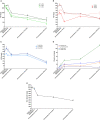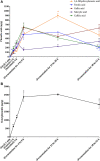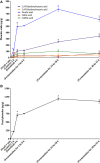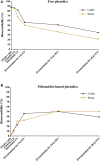Bioaccessibility and Gut Metabolism of Free and Melanoidin-Bound Phenolic Compounds From Coffee and Bread
- PMID: 34381807
- PMCID: PMC8349987
- DOI: 10.3389/fnut.2021.708928
Bioaccessibility and Gut Metabolism of Free and Melanoidin-Bound Phenolic Compounds From Coffee and Bread
Abstract
The aim of this study is to investigate the bioaccessibility and gut metabolism of free and melanoidin-bound phenolic compounds from coffee and bread. Phenolics from coffee were predominantly found in free forms (68%, mainly chlorogenic acids), whereas those from bread were mostly bound to melanoidins (61%, mainly ferulic acid). Bioacessibility of coffee total free phenolics slightly decreased during simulated digestion (87, 86, and 82% after the oral, gastric, and intestinal steps, respectively), with caffeoylquinic acids being isomerized and chlorogenic acids being partially hydrolyzed to the corresponding hydroxycinnamic acids. Bioacessibility of bread total free phenolics decreased during simulated digestion (91, 85, and 67% after the oral, gastric, and intestinal steps, respectively), probably related to complexation with the proteins in simulated gastric and intestinal fluids. Upon gut fermentation, the bioaccessibility of total free phenolics from both coffee and bread decreased, mainly after the first 4 h (56 and 50%, respectively). Caffeic and ferulic acids were the predominant metabolites found during coffee and bread gut fermentation, respectively. Melanoidin-bound phenolics from coffee and bread were progressively released after the gastric and intestinal steps, probably due to hydrolysis caused by the acidic conditions of the stomach and the action of pancreatin from the intestinal fluid. The bioaccessibilities of all phenolics from coffee and bread melanoidins after the gastric and intestinal steps were, on average, 11 and 26%, respectively. During gut fermentation, phenolics bound to both coffee and bread melanoidins were further released by the gut microbiota, whereas those from coffee were also metabolized. This difference could be related to the action of proteases on melanoproteins during gastrointestinal digestion, probably anticipating phenolics release. Nevertheless, bioaccessibilities of melanoidin-bound phenolics reached maximum values after gut fermentation for 24 h (50% for coffee and 51% for bread). In conclusion, the bioaccessibilities of coffee and bread free phenolics during simulated digestion and gut fermentation were remarkably similar, and so were the bioaccessibilities of coffee and bread melanoidin-bound phenolics.
Keywords: chlorogenic acids; ferulic acid; gut fermentation; maillard reaction; melanoproteins; melanosaccharides; simulated digestion.
Copyright © 2021 Alves, Lobo, Domingues, Monteiro and Perrone.
Conflict of interest statement
The authors declare that the research was conducted in the absence of any commercial or financial relationships that could be construed as a potential conflict of interest.
Figures





Similar articles
-
Bioaccessibility and gut metabolism of phenolic compounds of breads added with green coffee infusion and enzymatically bioprocessed.Food Chem. 2020 Dec 15;333:127473. doi: 10.1016/j.foodchem.2020.127473. Epub 2020 Jul 3. Food Chem. 2020. PMID: 32659670
-
Wheat bread enriched with green coffee - In vitro bioaccessibility and bioavailability of phenolics and antioxidant activity.Food Chem. 2017 Apr 15;221:1451-1457. doi: 10.1016/j.foodchem.2016.11.006. Epub 2016 Nov 2. Food Chem. 2017. PMID: 27979114
-
Breads enriched with guava flour as a tool for studying the incorporation of phenolic compounds in bread melanoidins.Food Chem. 2015 Oct 15;185:65-74. doi: 10.1016/j.foodchem.2015.03.110. Epub 2015 Apr 2. Food Chem. 2015. PMID: 25952842
-
Coffee melanoidins: structures, mechanisms of formation and potential health impacts.Food Funct. 2012 Sep;3(9):903-15. doi: 10.1039/c2fo30048f. Epub 2012 May 15. Food Funct. 2012. PMID: 22584883 Review.
-
Coffee Phenolics and Their Interaction with Other Food Phenolics: Antagonistic and Synergistic Effects.ACS Omega. 2022 Jan 4;7(2):1595-1601. doi: 10.1021/acsomega.1c06085. eCollection 2022 Jan 18. ACS Omega. 2022. PMID: 35071855 Free PMC article. Review.
Cited by
-
Barley Melanoidins: Key Dietary Compounds With Potential Health Benefits.Front Nutr. 2021 Sep 28;8:708194. doi: 10.3389/fnut.2021.708194. eCollection 2021. Front Nutr. 2021. PMID: 34651008 Free PMC article. Review.
-
Bioactive compounds in coffee and their role in lowering the risk of major public health consequences: A review.Food Sci Nutr. 2023 Nov 22;12(2):734-764. doi: 10.1002/fsn3.3848. eCollection 2024 Feb. Food Sci Nutr. 2023. PMID: 38370073 Free PMC article. Review.
-
Effects of In Vitro Digestion of Polyphenols from Coffee on Binding Parameters to Human Topoisomerase II α.Molecules. 2023 Aug 10;28(16):5996. doi: 10.3390/molecules28165996. Molecules. 2023. PMID: 37630250 Free PMC article.
-
Bioaccessibility and Genoprotective Effect of Melanoidins Obtained from Common and Soft Bread Crusts: Relationship between Melanoidins and Their Bioactivity.Foods. 2023 Aug 24;12(17):3193. doi: 10.3390/foods12173193. Foods. 2023. PMID: 37685126 Free PMC article.
-
Interest of Coffee Melanoidins as Sustainable Healthier Food Ingredients.Front Nutr. 2021 Oct 12;8:730343. doi: 10.3389/fnut.2021.730343. eCollection 2021. Front Nutr. 2021. PMID: 34712686 Free PMC article. Review.
References
-
- Echavarría AP, Pagán J, Ibarz A. Melanoidins formed by maillard reaction in food and their biological activity. Food Eng Rev. (2012) 4:203–23. 10.1007/s12393-012-9057-9 - DOI
LinkOut - more resources
Full Text Sources

